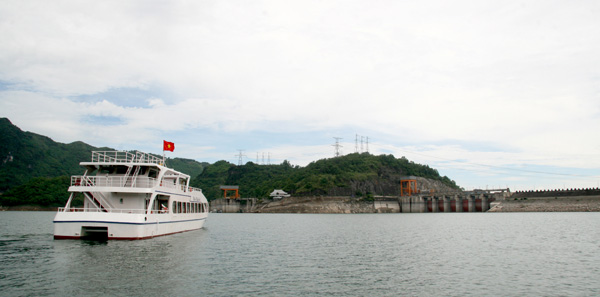
(HBO) – Hoa Binh hydropower plant has become a unmissable destination of any exploration boat trip along the Da River in Hoa Binh province. The plant is indelibly etched on tourists’ minds with powerful generation turbines, while a traditional house keeping a century letter sent to future generations, a President Ho Chi Minh statue and a memorial statue memorising Vietnamese and Russian experts who died during the plant construction give them a deep insight into historical values of the plant.

Hoa Binh hydropower plant is
part of the Da River tour
The granite statue of President Ho Chi Minh,
18 metre in height and
over 400 tonnes in weight, was placed on the top of Tuong Hill in the Hoa Binh
hydropower plant complex. It looks like Uncle Ho is watching local officials
and people making concerted efforts to build a prosperous Hoa Binh province.
From the statue, which is
128
metres above sea level, visitors can enjoy a picturesque
landscape of the giant hydropower plant, immense Hoa Binh reservoir, and afar
distant mountain ranges.
Paying tribute to the late President reminds visitors of a time in 1960 when
taking a boat trip on the Da River, President Ho Chi Minh said that the river
must be conquered to bring long-term benefits to people. And his wish came
true.
In the past decades, Hoa Binh hydropower plant has been consistently generating
power for the country’s renovation process.
To realise the Party and Government’s "electrification” orientation, tens of
thousands of officers, engineers and workers had made tireless efforts to race
against time to complete the construction of the plant. The region was once
teeming with emulation slogans and streaming national flags. It was crowded
with transporters bringing goods, rocks and building materials around the clock.
Trans-mountain tunnels, hundreds of metres in depth, were built on time. Million
tonnes of soils and stones were dug and gathered for blocking the river. Great
endeavors had been made and even blood was shed for the national electricity.
The eight-turbine Hoa Binh hydropower plant with total designed capacity of
1,920 MW became operational and connected with the national grid on December
20, 1994. The plant manifests the sacrifice and industriousness of officers and
experts from
Russia.
168 Russian officials, workers, and experts laid down their lives during the
construction of the plant, making it a symbol of great Vietnam-Russia
friendship relations.
Today,
officers and engineers from the Hoa Binh Hydropower Plant Company are making constant
efforts to manage the plant and generate over 200 billion kWh of electricity for
the national grid, making contributions to the nation’s industrialisation and
modernisation./.
Le Chung
The People’s Committee of Lac Son district held a ceremony on April 28 to receive the provincial relic certificate for the ancient rock carving site at Suoi Co stream, located in My Thanh commune.
A special music show titled "The country is in the fullness of joy” has been held at Hoa Binh Square in Hoa Binh city in celebration of the 50th anniversary of the liberation of the South and national reunification (April 30, 1975–2025).
The People's Committee of Lo Son commune, Tan Lac district, has organised the local annual traditional stream fishing festival on April 19 - 20.
As a land deeply intertwined with human history and Vietnam’s millennia-long journey of nation-building and defence, Hoa Binh is often revered for its epic tales and legends.
Residents of Hoa Binh boast a rich cultural identity, reflected in their unique language, traditional attire, customs, and folk melodies – described as "sweet as honey, clear as a mountain stream.”
Lac Son district’s Vu ban town held the 2025 Truong Kha temple festival on April 12–13 (the 15th–16th days of the third lunar month). Since its revival in 2019, the festival has been organised every three years, preserving valuable intangible heritage while meeting the community’s cultural and spiritual needs.



